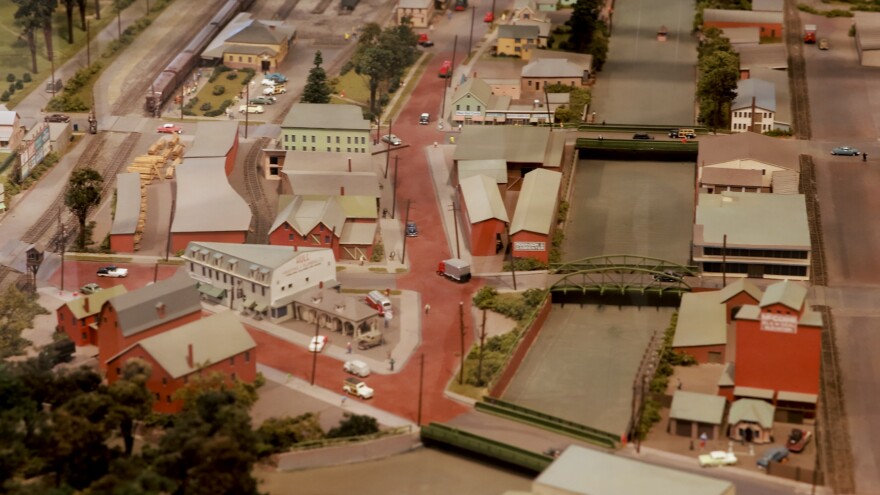The grey walls of the Cherry Gallery in Ithaca are covered with paintings. Sculptures make a swirling descent from the gallery’s ceiling.
Tucked away in the back corner of the gallery sits a massive diorama encased in glass. Tiny forests give way to a lively miniature community. It is populated by brightly colored buildings, a train station, and bustling city streets.
The diorama is a memory of an old Ithaca neighborhood, one that artist David Fogel has spent years of his life recreating.
The piece, called the "West End Diorama,” is a scale-model recreation of Ithaca's old West End neighborhood, as it looked back in the 1950s.
Pocket-sized people pepper the diorama, frozen on a typical day.
“There's a group of teenagers washing their jalopy and parking lot over there,” Fogel pointed out while giving a tour of the diorama. “There's a couple of police cars parked next to each other.”

Fogel worked on the piece on and off for eight years, finishing it in 1986.
“I saw it as a real challenge to reconstruct the neighborhood as it looked back then,” he said.
Since then, the diorama has had multiple homes and even spent some time in storage. Now Fogel is planning for Cherry Arts to be the diorama’s permanent steward.
The gallery is located in the same neighborhood recreated in the diorama, although the area has changed a lot since the period depicted in the piece.
In some ways, the diorama looks a lot like the West End of today with its busy streets and businesses. However, there are some big differences.
During his tour of the diorama, Fogel took special care to point out the Beebe Chapel, a nondenominational Christian chapel in the West End.
“There's a wedding party coming out with the bride and groom and a group of people greeting them,” Fogel described.
Now that chapel, and many of the other houses, community centers and buildings standing in the diorama, are gone.
The land they once stood on is now underwater, swallowed by a flood control project taken on by the Army Corps of Engineers in the 1960s.
“It essentially wiped out the whole residential aspect of the neighborhood,” Fogel said.
The project created a flood control channel to help mitigate some of the flooding in the area.

City of Ithaca historian Margaret Hobbie said homes were bought out and destroyed so the project could be completed.
“We lost the chapel. We lost 55 out of 65 residences, so there was a great cost,” she said.
The neighborhood was made up of working-class people, many of whom were the children of European immigrants who came to Ithaca in the 1920s.
Hobbie said it is likely they did not feel empowered to push back against the project.
“I think by the 70s, people felt you could fight city hall. But at the time that this was happening to this neighborhood, I don't think people felt that it was worth fighting,” Hobbie said.
She added some Ithacans outside of the neighborhood thought of the West End as “a little dubious.”
“There was a lot of fear and trepidation from people in other parts of the city, whereas the people who lived in the neighborhood felt safe and had very happy memories of their neighbors and neighborhood activities,” Hobbie said.
Emm Thurston grew up in the West End and used to host “Rhiners reunions” for people who used to live in the neighborhood. The title refers to the old nickname for people from the West End.
Thurston was just a kid when the flood control channel was created.
“I remember everybody, all the kids, talking about, ‘Are you leaving? Did they sell your house?’” she said. “So there was some sort of measuring of who was going and who was staying.”
Thurston’s family got to stay in their house, but she remembers when her neighborhood started to empty out.
“I was a little elementary school girl, in fifth or sixth grade, when all the kids moved away,” Thurston said.
Thurston remembers firefighters using the old homes for training. They even let neighborhood kids throw rocks through the windows of homes before burning them for practice.
“It was really weird as a little kid to watch your neighborhood get burned to the ground, and then watch this new canal be literally dug out of the ground,” Thurston said.
Despite the drastic changes that took place, Thurston still remembers her old neighborhood when it was full of life.
“I think of the sounds of people laughing and playing and screaming, the laughter of children on a playground,” she said. “That's what it sounded like to me.”
She said she is glad the history of the West End is being preserved.
Artist David Fogel hopes his diorama can capture the memory of the neighborhood, even after the people who experienced it firsthand are gone.
“Twenty to 30 years from now, there won't be anyone around who remembers this,” he said. “But hopefully, hopefully the diorama will still be here.”
Fogel will be giving guided tours of the diorama the next two Saturdays from 2 p.m. to 4 p.m. at the Cherry Gallery on the ground floor of the Ithaca Arthaus.


